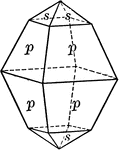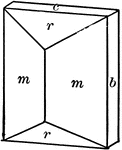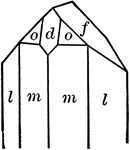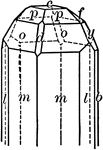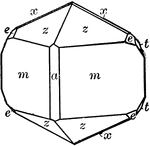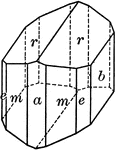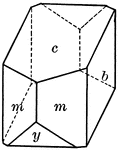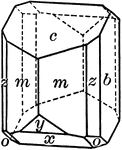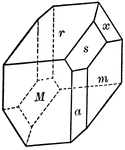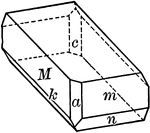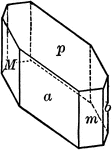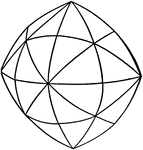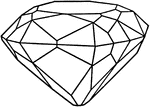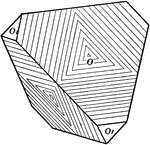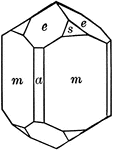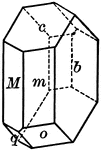
Right-handed quartz
"The quartz crystals are said to be right or left handed, depending upon whether these faces are to…

Left-handed quartz
"The quartz crystals are said to be right or left handed, depending upon whether these faces are to…

Pyramid
"An orthorhombic pyramid has eight triangular faces, each of which intersects all three of the crystallographic…

Calamine
"The only orthorhombic mineral of importance belonging to the hemimorphic class is calamine. When its…
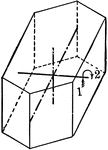
Symmetry of monoclinic system
"The symmetry of the Monoclinic System is as follows: The crystallographic axis b is an axis of binary…
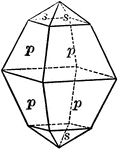
Sulphur
"Resinous luster. Color sulphur-yellow, varying with impurities to yellow shades of green, gray, and…

Sulphur
"Resinous luster. Color sulphur-yellow, varying with impurities to yellow shades of green, gray, and…

Chalcocite
"Orthorhombic. Usually in small tabular crystals with hexagonal outline. Striated parallel to the brachy-axis."…
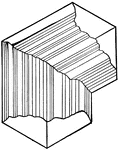
Chalcocite
"Orthorhombic. Usually in small tabular crystals with hexagonal outline. Striated parallel to the brachy-axis.…

Marcasite
"Orthorhombic. Crystals commonly tabular parallel to basal plane, showing also short prisms and low…

Arsenopyrite
"Orthohombric. Usually in tabular diamond-shaped crystals, formed by a short prism terminated by low…
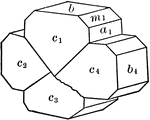
Bournonite
"Orthohombric. Crystals usually short prismatic to tabular. Sometimes quite complex with many prism,…

Quartz
"Terminated usually by a combination of a positive and negative rhombohedron, which often are so equally…

Quartz
"Terminated usually by a combination of a positive and negative rhombohedron, which often are so equally…
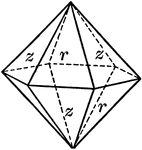
Quartz
"Terminated usually by a combination of a positive and negative rhombohedron, which often are so equally…
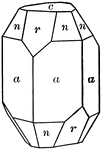
Corundum
"Hexagonal-rhombohedral. Crystals usually prismatic in habit or tapering hexagonal pyramids." —…

Corundum
"Hexagonal-rhombohedral. Crystals usually prismatic in habit or tapering hexagonal pyramids." —…

Hematite
"Hexagonal-rhombohedral. Crystals usually thick to thin tabular. Basal planes prominent, often showing…
Hematite
"Hexagonal-rhombohedral. Crystals usually thick to thin tabular. Basal planes prominent, often showing…
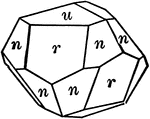
Hematite
"Hexagonal-rhombohedral. Crystals usually thick to thin tabular. Basal planes prominent, often showing…
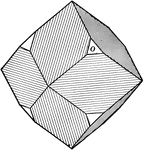
Magnetite
"Isometric. Octahedral habit, sometimes twinned octahedrons. Dodecahedron at times, either alone or…

Cassiterite
"Tetragonal. Common forms are prisms and pyramids of first and second orders." — Ford, 1912
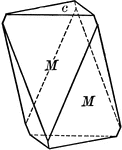
Calcite
"Hexagonal-rhombohedral. Crystals are very varied in habitat, often highly complex. Over 300 different…

Calcite
"Hexagonal-rhombohedral. Crystals are very varied in habitat, often highly complex. Over 300 different…
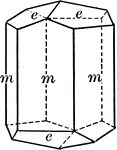
Calcite
"Hexagonal-rhombohedral. Crystals are very varied in habitat, often highly complex. Over 300 different…

Calcite
"Hexagonal-rhombohedral. Crystals are very varied in habitat, often highly complex. Over 300 different…
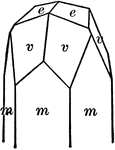
Calcite
"Hexagonal-rhombohedral. Crystals are very varied in habitat, often highly complex. Over 300 different…

Dolomite
"Hexagonal-rhombohedral. Crystals are usually the unit rhombohedron (cleavage rhombohedron). Faces often…
Aragonite
"Orthorhombic. Acicular pyramidal; consisting of a prism terminated by a combination of a very steep…

Aragonite
"Orthorhombic. Tabular; consisting of prominent brachypinacoid faces modified by a prism and a low brachydome."…

Cerussite
"Habit varied and crystal show many forms. Crystals often tabular parallel to brachypinacoid." —…
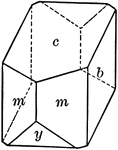
Orthoclase
"Monoclinic. Crystals are usually prismatic in habit and have as prominent forms, clinopinacoid, base,…

Orthoclase
"Monoclinic. Crystals are usually prismatic in habit and have as prominent forms, clinopinacoid, base,…
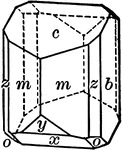
Orthoclase
"Monoclinic. Crystals are usually prismatic in habit and have as prominent forms, clinopinacoid, base,…
